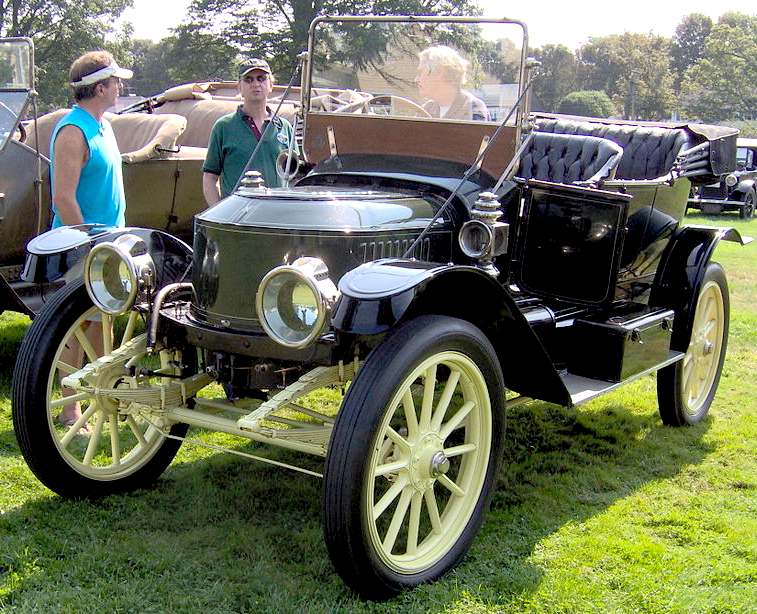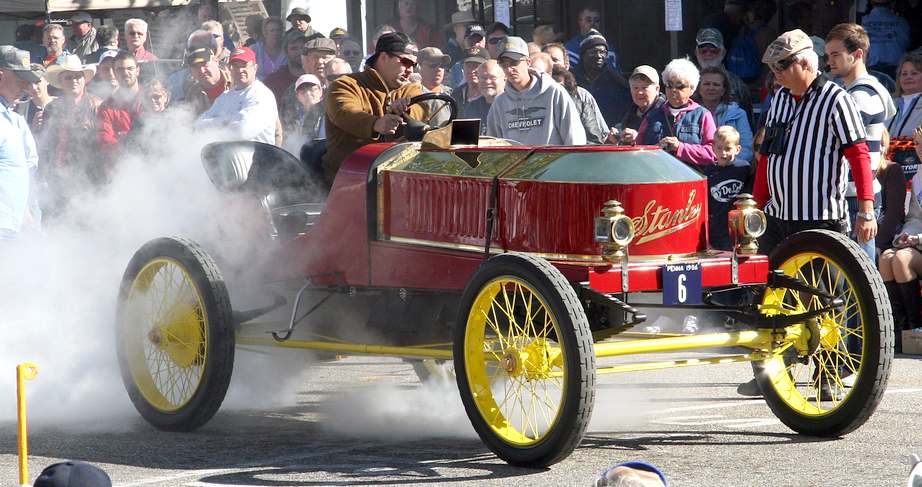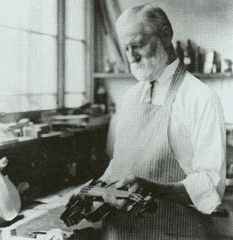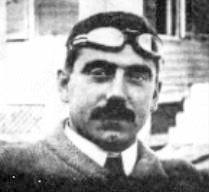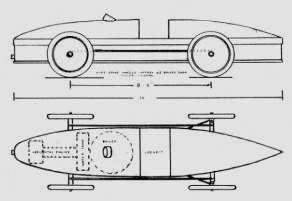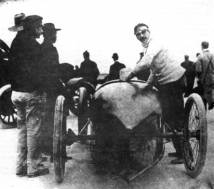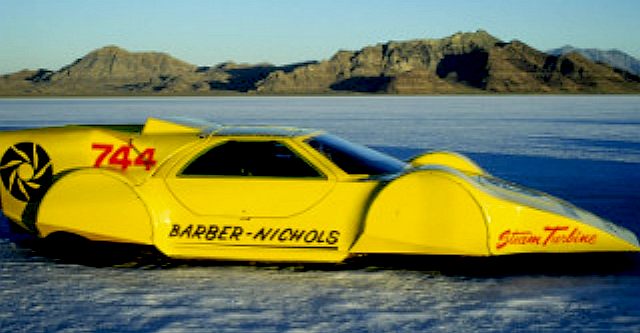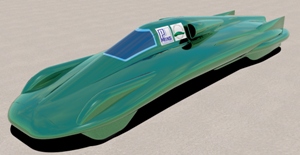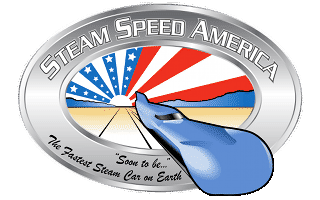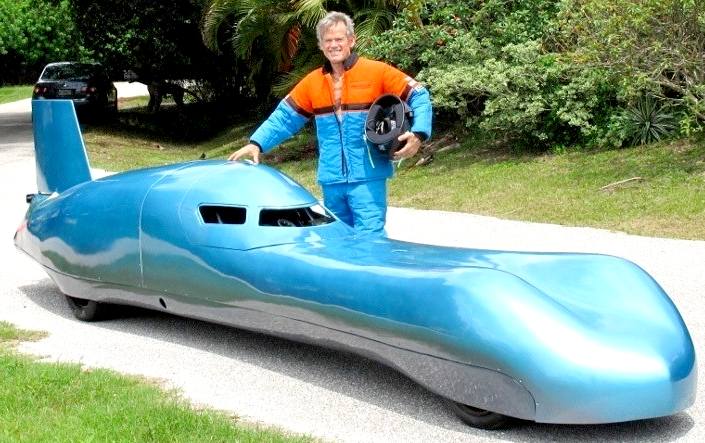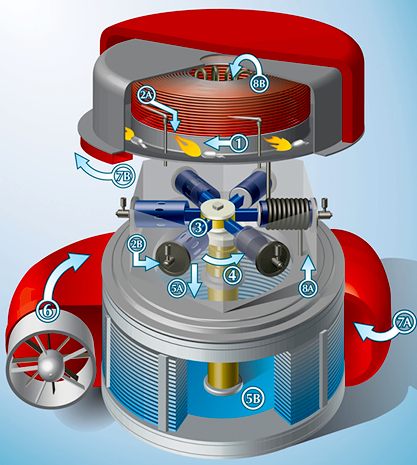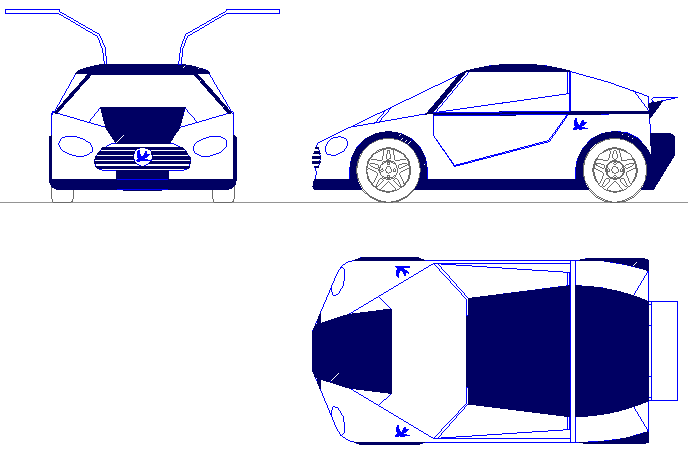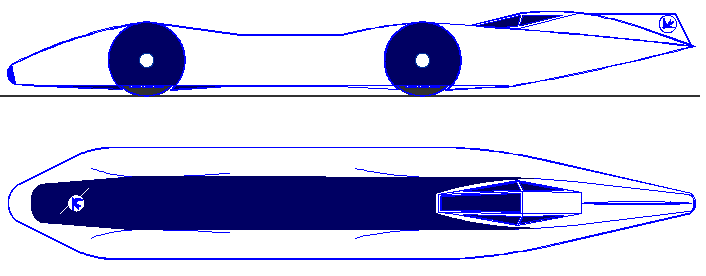|
STANLEY STEAMER - 1906
|
|||||||||||||||||||||
|
STANLEY BROTHERS
The Stanley Motor Carriage Company was an American manufacturer of steam-engine vehicles; it operated from 1902 to 1924. The cars made by the company were colloquially called Stanley Steamers, although several different models were produced.
The engine had two double-acting cylinders side-by-side, equipped with slide-valves, and was of the simple-expansion type. Drive was transmitted directly from the engine crankshaft to a rear-mounted differential by means of a chain. Locomobiles were often modified by their owners, who added third-party accessories, e.g., improved lubricators, condensers, and devices which mitigated the laborious starting procedure, and so forth.
OBSOLESCENCE SALE & CLOSURE
LAND SPEED RECORD
The longest standing steam Land Speed Record was set in 1906. With driver Fred Marriot at the wheel, the Stanley Steamer managed 127.659 mph.
F. O. Stanley
In 1906 the sands of Ormond Beach, now called Daytona Beach, hosted internationally; recognized land speed record attempts. The Dewar International Trophy was to straightaway land speed competition what the Americas Cup was to yachting. The only vehicles vying for the Dewar Trophy that year were the Stanley’s steamer and four petrol powered cars, three being Fiats and one Napier. Fred Marriott won cleanly in the Stanley Steamer with a measured mile time of 28 1/5 second which corresponds to a speed of 127.659MPH.
Fred Marriot and the Stanley Steamer
The record set in 1906 is of significance as it is the longest standing FIA recognized LSR. It was set in the days when gasoline powered internal combustion engines were competing neck-and-neck with steam powered external combustion engines for commercial market share. In the midst of this commercial battle were twin brothers F.E. and F.O. Stanley, known for their Stanley Steamer. Their innovative vehicles were in very high demand early in the 1900s. Their shop constructed several thousand cars in the early part of the nineteenth century but they were overshadowed by the petrol powered internal combustion engines gaining prevalence in the market.
Stanley Steamer - Drawings
The car was constructed by the Stanley brothers and was a technological marvel for its day. The Stanley brothers created a car that had extremely low drag, incorporating as much inside the cigar shaped body shell as possible including the suspension springs. The engine was a twin piston double acting type with a displacement of 184 cubic inches or 3.1 litres. This corresponds roughly to an internal combustion 4 stroke V8 with a displacement of 735 cubic inches or 12.25 litres. The working pressure claimed to be either 275 or 1000 psi depending on the report with a temperature of 700 degrees F. With the power required to drive the vehicle at the recorded speeds the 1000 psi is most likely the correct figure. The car was 16 feet long and 3 ft wide at its widest part with a total frontal area of 9 sq. ft including wheels. The total vehicle weight was 1675 lbs.
Stanley Steamer - side view showing wire wheels
In 1999, the British Steam Car Challenge was launched with the twofold aim of breaking the land speed record for steam powered vehicles as well as creating some excitement in the arena of alternate fuels. It is hoped that the project will help the trend toward more fuel efficient and cleaner burning vehicles for the future of transportation. The project was officially kicked off in June of 1999 with a luncheon hosting members of the team, sponsors and distinguished guests including Lord Montagu of Beaulieu as the patron of the project. The car, named Inspiration after the effect we hope it will have, is to be on loan to the National Motor Museum Trust at Beaulieu after the 200 MPH barrier has been broken.
The first mention of a steam powered vehicle will usually conjure images of ancient tiller steered motor cars and pre-war rail engines. It was during the early nineteen hundreds that the petrol engine gained dominance in the personal transportation marketplace. While not exactly new in concept, steam powered vehicles have potential that today’s internal combustion engines lack. While the compact size and robust power density figures make the internal combustion engine attractive, its drawback also stems from its popularity.
Stanley Steamer - Rear
BOB BARBER & STEAMIN DEMON - 1985
In 1985, a steam turbine-powered vehicle modified and driven by Bob Barber set a new Land Steam Record of 145.607 MPH at the Bonneville Salt Flats. However, this record was not recognized by the F.I.A as official, since the Barber vehicle set the record running two timed runs in the same direction. The F.I.A requires that timed runs be made in both directions, within one hour, with the average speed of the two runs becoming the record speed.
The 1977 turbine-powered Steamin' Demon displayed here was built by Jim Crank, a steam car buff, who purchased the engine from Lear Motors and built the body with help from Fiber Fab and Volkswgen of America. He attempted to break the Land Speed Record for steam-powered cars set in 1906 by Stanley Steamer's "Stanley Rocket" at 127.656 mph. Crank was unable to reach 100 mph and sold the car in 1982 to Barber-Nichols Engineering Company in Colorado. They rebuilt the car and tried for the record at El Mirage, California, reaching 111 mph. The company tried again in 1984 at Bonneville Salt Flats reaching 110 mph. Success came on August 19, 1985, when Robert Barber drove the Barber-Nichols Steamin' Demon at Bonneville to a new record of 145.607 mph. This remains the current world record. Barber said that when he reached 140 mph, the door jiggled loose and blew off and, at the end of the run, the engine compartment was on fire. The 250 hp Steaming' Demon weighs 5,000 pounds, 1,000 pounds of which represents the stainless steel steam boiler. The boiler holds 60 gallons of water. When floorboarded, the steam reaches 1,000 degrees Fahrenheit at a pressure 900 pounds per square inch. The super heated, high pressure steam then feeds into a 60,000 rpm turbine.
BRITISH STEAM CAR CHALLENGE
The British Steam Car Challenge was conceived with the twofold aim of breaking the land speed record for steam powered vehicles as well as creating excitement in the arena of alternate fuels. It is hoped that the project will create interest among the next generation of engineers and designers to work toward cleaner and safer forms of transportation, both public and private.
The current reliance of the internal combustion engine on highly refined hydrocarbon based fuels makes the external combustion engine an attractive concept for many applications. External combustion engines such as the steam engine are not fuel specific, meaning that any fuel can be used.
Similarly, the technology used in the project is far from antiquated. In fact, some leading edge technologies have been employed to make the record attempt possible. The development phase of the project includes over 18 months of proof-of-concept and research work on the steam generation and power delivery systems. Students quickly developed a vehicle that would, in theory, set a new record. They devised the shape and general concept of the project including the amount of power required to push that shape to the 200 MPH mark.
British LSR Steam Car 2004
The team say that the most enduring part of the project is the ongoing education of students and the public after the Land Speed Record has been set. What we have accomplished with this vehicle is an integrated approach to a land speed record. An innovative boiler design, high performance turbine, aerodynamically slippery shape and clean burning fuel all combine to make this vehicle an extremely technologically and ecologically advanced project. But the overall aim of the project is to promote education and awareness of clean burning fuels and ecologically sound technologies to young engineers all over Britain. The project is also a chance for some hopefuls to keep their name in the limelight to rekindle interest in their own projects, generously provided by the project members, despite detracting to some extent from the efforts of the team.
It is the hope of the team and many of the project supporters to bring another land speed record to Britain. The car is being designed and constructed in the UK, and the first of two record attempts will be made in the UK. Automotive racing has always pushed the envelope of technology and led the forefront of automotive change. Man’s desire to go faster has led to advances in existing capabilities.
THE TEAM:
Lady
Driver - Annette
Getty
LPG
System Designer - John
King
Team
Coordinator and Administrator - Lynne
Angel Senior
Test and Car Build Technician - Shaun
Arnold STEAM
CAR LINKS: Steam
Homepage | News
| Team
| Design
| Challenge Car
| Aerodynamics
| Construction
| Engine/Drive
Train | Boilers
| Safety
Systems | Side-on
| Above
(Plan) | Front
Aspect | Rear
Aspect | Specifications STEAM
SPEED AMERICA The STEAM SPEED AMERICA Streamliner has proven itself during
a preliminary testing program at Bonneville in October 2012. The testing and development program has continued - right up to the present. Through the spring and summer of 2013,
the team did quite a rebuild and redevelopment of the steam
generator-burner, as well as an exhaustive series of dyno tests on the entire drive train.
The intention is to make their record attempt at the World Finals, but the event was cancelled because of rain. Chuk Williams' Steam Land Speed Record car
is well planned with outstanding fit and finish, it was the star of the steam shows
until Team Steam USA was formed. The Cyclone Mark 5 engine installation has found an excellent forum to demonstrate it's potential, with a huge audience awaiting performance trials of this debutante clean, green multifuel powerplant. The engine used in the LSR Streamliner will be a stock 6-cylinder Cyclone Mark V automotive engine, intended for use in regular cars. It is said to be capable of producing 100 HP with a maximum starting torque of 850 ft/lbs, and should hopefully propel the car to over 160 mph (257.5 kph). However, as the record breaking attempt will only require a run of a few minutes meaning the water won't need to be reused, the engine won't have a full condensing unit. STEAM
SPEED USA Harry Schoell is Chairman and CEO of Cyclone Power
Technologies. He is the inventor of the Cyclone Engine that will power Team Steam USA’s attempt to break the Land Speed Record for steam vehicles. Under Harry’s leadership, Cyclone has received over 29
patents for the Cyclone Engine, the “Invention of the Year” Award from Popular Science, two SAE Tech Awards, and major contracts from Raytheon and the U.S. Army. Harry
made his mark in the marine design, power and propulsion fields, and was recently named as one of the true “Game Changers” in the industry by Boating Magazine. Cyclone Power Technologies is a research & development company focused on helping solve two of the great problems of our time: our dependence on fossil fuels, and the resulting unsustainable consequences to our environment.
The Cyclone Engine is a Rankine Cycle heat regenerative external combustion, otherwise known as a “Schoell Cycle” engine. In short, the Cyclone is a 21st century, high efficiency, compact and powerful steam engine.
The Cyclone Engine is capable of running on virtually any fuel (or combination of fuels) including today’s promising new bio fuels, while emitting far fewer pollutants than traditional gas or diesel powered internal combustion engines. Based on the ground breaking designs of the George Poteet and
Ron Main Bonneville-proven streamliner, Speed Demon, the Cyclone vehicle will feature state-of-the-art technology and unmatched aerodynamics. The body will be approximately 25’ long, 33” wide and 34” high (not including tail). The vehicle will have a drag coefficient (Cd) of an amazing 0.08. Cyclone Power Technologies, Inc. REFERENCE Wikipedia
Stanley_Motor_Carriage_Company Gizmag
US team attempts steam land speed record Gas2
2011 American-team-aims-to-reclaim-steam-land-speed-record Daily
Mail
Success-British-steam-supercar-smashes-100-year-old-land-speed-record http://gas2.org/2011/01/27/american-team-aims-to-reclaim-steam-land-speed-record/ http://www.gizmag.com/us-team-attempts-steam-land-speed-record/17755/ http://www.cyclonepower.com/ http://www.steamspeedamerica.com/index.html http://www.uslandsteamrecord.com/ http://en.wikipedia.org/wiki/Stanley_Motor_Carriage_Company
Team
Speedace plan to run the Ecostar
DC50
above on the from John O'Groats in Scotland to Lands End in Cornwall in
an attempt to beat the current record set in a Tesla
in 2013. Contact Chris or Terry for
details. Donald Campbell would have loved to see the blue bird logo on a
road car. This is a fitting tribute to the speed king on the 50th
anniversary of his land (16-7-64) and water (31-12-64) speed double
whammies in 1964.
The
Bluebird World Cup Trophy challenge
The
blue bird
legend continues with this
Reid Railton inspired
design that benefits from pointers from Ken
Norris, as to materials and drive layout. This is possibly the
world's fastest electric car: 350mph + using energy from nature.
Featuring built in battery cartridge exchange, charged using renewable
solar energy. Sponsors sought for the 2016 season. |
|||||||||||||||||||||
|
This
website is copyright © 1991- 2014 Max Energy
Ltd. All rights
reserved. The bird logo |
